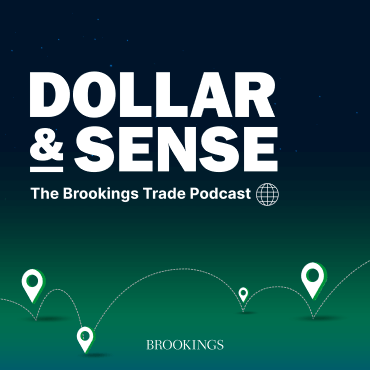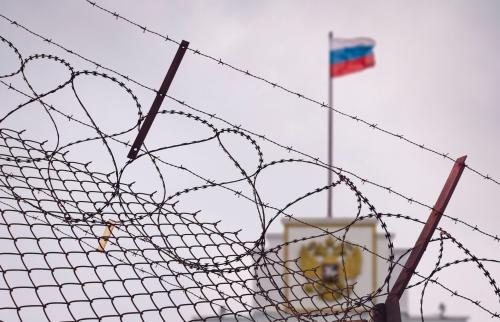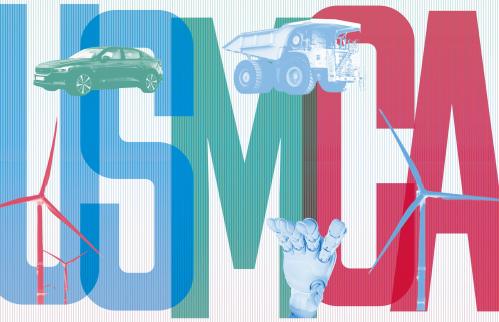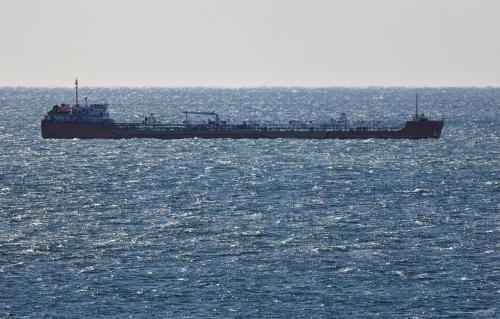The coronavirus pandemic has sent crude oil prices plummeting, so much so that the price for West Texas Intermediate oil dropped below zero dollars earlier this week. In this special edition of the podcast, Samantha Gross joins David Dollar to explain the factors influencing recent changes in demand for oil and the long-term effects the coronavirus could have on U.S. oil production and the development of renewable energies.
Related content:
No winners, only strange bedfellows, from the new OPEC+ deal
Will investments in greener energy be yet another victim of the coronavirus?
The Saudi Aramco IPO and the future of global oil markets
This transcript has been lightly edited for clarity.
DOLLAR: I’m David Dollar, host of the Brookings trade podcast, “Dollars & Sense.” This is a special episode about developments in the oil markets. My guest is Samantha Gross, a fellow in the Energy Security and Climate Initiative at Brookings. Welcome to the show! I should say welcome back to the show because we had a good earlier discussion.
GROSS: Thanks, David. It’s always a pleasure to talk to you.
DOLLAR: So the reason for the special episode is we were all shocked to see the price of oil actually turn negative this week. So what does that mean for the price of oil? Do you have to pay someone to take oil off your hands? What’s happening there?
GROSS: Yeah, well, let’s talk a little bit about what really happened there. It wasn’t that the price of all crude oils went negative. It was a very specific contract for a very specific type of crude oil. This was West Texas Intermediate, which is the main crude benchmark here in the United States, for delivery in May. And what happened is that contract expired yesterday — that’s Tuesday, March 21st as we record this. And that contract delivers crude oil on that set date at Cushing, Oklahoma, a specific place on a specific date. And as that contract was expiring, that meant that that oil was ready to be delivered. But storage at Cushing, Oklahoma, was either full or contracted out. And so those folks who still had that May contract in-hand were really kind of in a pickle if they were going to get that oil delivered. If they didn’t need the wet barrels of crude oil, or they didn’t have a place to store it, they were kind of in trouble. So at that point you couldn’t give those contracts away. The price implications of not being able to give it away were that the prices went negative. You had to pay somebody to take that contract off your hands.
But overall, global crude prices didn’t go negative, although they’ve really dropped tremendously given the incredible drops that we’ve seen in crude oil demand. Even WTI, West Texas Intermediate, the U.S. crude, has gone positive over the last couple of days. It was about 11 or 12 dollars when I checked at the end of the day yesterday. A good global benchmark for crude oil prices, which is Brent Crude, is below 20 dollars, which is still as low as we’ve seen in a long time. So not negative, but seriously low oil prices.
DOLLAR: Right. So I think we can agree the negative was an anomaly, but let’s just go a little bit more into what’s actually happening. What are the supply and demand factors in the oil market that are driving those prices you just mentioned to the 15 to 20 dollar range, basically?
GROSS: The most important factor here is definitely demand. Given what’s happening with COVID-19 and with the world’s response to COVID-19, we’ve seen demand for crude oil just go through the floor. About 60 percent of global crude oil demand goes into transportation — moving goods and people around — and that demand has just plummeted. Instantaneous demand right now may be down as much as 25 percent. So that’s 25 million barrels a day off of a 100 million barrels-a-day market. We’ve never seen crude oil demand drop this far and this fast.
There’s also a price war last month between the Saudis and the Russians. That certainly didn’t help. They couldn’t agree to cut production for a while and so they decided to increase it instead. So we saw prices go down further and faster than we might have right at the beginning of the crisis, but given the level of demand destruction that we’ve seen, there was no avoiding plummeting prices. This was just going to happen.
And I think prices could go even lower than we’re seeing today, frankly. The way to think about this is how producers make decisions about how much oil that produce. We often hear numbers about how much it costs to produce a barrel of oil all-in. For many of the producers in Texas, in the Permian basis for instance, you’ll hear 30 or 35 dollars a barrel. So you say to yourself, well, why are they producing any oil right now at the prices we’re seeing? But they make those decisions based not on that all-in price, they make it based on what it costs to produce the next barrel — the marginal price. And that can be a lot lower. For a well that’s already been developed and is already producing it doesn’t cost that much to get that next barrel out of there. Additionally, it costs some money to shut a well in and to stop producing from it. You’re not just going out and turning a valve. And it may cost money to start that well up again. And so they’re taking all these costs into account when they decide to shut down a well. So you may need some really low prices in order to get not just the U.S. producers, but global producers to shut-in production and that’s what we’re seeing right now.
DOLLAR: So there’s going to be a lot of uncertainty, obviously. Oil markets are always difficult to predict, but probably we’re in for a prolonged period of low prices because that demand drop you talked about, that’s not going to reverse very quickly. So let’s speculate a little bit about what will happen to U.S. oil production in this environment. This has been one of the big developments in economics in recent years is the self-sufficiency of the United States and oil. What’s going to happen now?
GROSS: Well, U.S. oil and gas producers are going to hurt. Oil and gas producers around the world are going to hurt just because of this level of demand destruction, but they’re going to particularly hurt in the U.S. Part of the reason for that is because U.S. producers need to keep drilling in order to keep their production going. So more of those producers are making their decisions on that maybe $35 a barrel price and not the much lower per barrel price that they would see if that well was already drilled.
We’re going to see significant job losses here in the United States — I think no matter what happens. We see rhetoric from the president about saving jobs in the industry, but if we’re not drilling new wells going forward because we don’t need the oil there’s not much you can do to save those jobs. About 50,000 direct jobs in the oil industry were lost just in the month of March, and I’ve seen numbers that we could reach 150,000 job losses directly in the industry. That’s not counting sort of the associated jobs that come along with that — the jobs that those income support. So this could be really significant. You’ll see those job losses particularly in Texas and New Mexico in the Permian Basin, and also often up in North Dakota in the Bakken. Those are really productive areas for the U.S., but they may be out of the money for a while.
DOLLAR: Right. Those are mostly Trump states; not New Mexico.
GROSS: They are indeed.
DOLLAR: I think I read Oklahoma is in this group.
GROSS: Yep!
DOLLAR: So the president is going to try to make an effort to help with jobs in those sectors, but I think that’s probably pretty difficult.
GROSS: I think there’s precious little he can do.
DOLLAR: Looking out more like three to five years, which is extremely speculative, are we going to continue to be self-sufficient in oil? Or are we going to look back and find that was just a blip in economic history?
GROSS: You know, in the three to five-year time range it really depends on how long the virus takes. I feel like a lot of the talking I’ve been doing over the past month or so — the virus will have to answer these questions for us. How long does it take us to get the virus under control? To get back to normal to normal economic activity? It depends on how long oil demand stays low. But as far as U.S. self-sufficiency, I still think that could come back. The reason why is producers in the U.S. know how to produce those oil resources at very reasonable prices historically. And when prices recover, that production will come back. We know the oil is there and we know how to produce it where producers can make money at some pretty reasonable oil prices.
It’s true that not all U.S. companies will survive. There are a lot of smaller independent companies in the U.S. oil industry, and a lot of them will probably go bankrupt and their assets will be picked up by stronger or perhaps more diversified companies that can then go back to producing those assets when demand returns. So we’ll see a different structure to the industry, but I think when prices recover it’ll come back.
DOLLAR: You were suggesting a moment ago there’s really not much President Trump can do in the short run. It is probable that Democrats are not going to agree to any kind of bail out of the oil industry. He has talked about putting a tariff on imported oil, or even mentioning banning imports of oil from Saudi Arabia, so let’s just talk this through a little bit. What would happen if the U.S. really restricted imports of oil into the U.S. economy?
GROSS: Well, he could do that, but I don’t think it’s very helpful overall and here’s why. The way the U.S. oil industry has worked over these past few years is that we export the light sweet oil that we’ve been producing so much of and then we import heavier oil that’s a better fit for the refinery system that we have, particularly down on the Gulf Coast. And so if you were to ban imports of oil and force all these refineries to run domestic oil, you might help the domestic producers, but you would harm the domestic refining industry. And you have to think that that refining industry is already hurting. They’re running at less capacity because we’ve had such a low demand for fuels. So they’re running inefficiently anyway because they’re running at lower capacity and then they’re going to run even more inefficiently if they’re running on crudes that they weren’t designed for. So you might be helping one corner or the oil industry while damaging another and also while damaging the U.S. role in the global oil industry in general. We are a free trade country, we make decisions based on economics, and I hate to see us destroy that position and act completely differently just because of this crisis when it actually wouldn’t help many of the folks it was intended to help anyway.
DOLLAR: Right. So for me as an economist, it’s just striking that, you know, we’re probably looking at 15- 20 dollars a barrel oil for quite a few years, and it sounds like the domestic industry would need much higher prices in order to really be supported. So then you’re going to have all the oil users in the US, different types of companies and, of course, consumers who drive. It’s just not politically sustainable for people to see that oil prices have dropped, but somehow they’re being excluded from that benefit. So I think we agree, Sam, it’s not really politically sustainable.
GROSS: Yeah, I completely agree. And also, I mean, even from an environmental perspective, it’s inefficient to run those refineries inefficiently. I don’t know if they’ll stay in the 10-15 dollar a barrel range for years and years, but we’re certainly looking at that for a while and you can’t prop up a domestic oil production industry for that long.
DOLLAR: So let’s take the last question about whether this is going to have a big impact on the whole development of renewables in the U.S. It’s a different but related topic. We’re making some progress with solar, wind, and electric vehicles. And as you say, we don’t know how long we’re going to have this low oil price, but personally I don’t think the world recovery is going to come very quickly. So I think we’re going to be stuck with this environment for quite a while. So what does that do for the development of renewables in the United States?
GROSS: You have to think about the energy market as being cut into a couple of different pieces. One of them is the electricity market where you see renewables, primarily wind and solar, competing with natural gas and with coal. And so the fact that associated natural gas is also pretty inexpensive really could push renewables back. However, in the oil market, you don’t see oil competing with renewables quite so directly. I think this will cut back the push for electric vehicles, unfortunately, because we’ll see low fuel prices and that will make electric vehicles slightly less attractive from a difference in fuel price point of view.
The other thing I worry about with renewables is less about oil price and more about the economy in general. We’re seeing companies and governments go into a ton of debt to deal with the immediate crisis and to keep people employed and fed and keep the economy from coming to a complete stop. And so we’re in an immediate crisis mode and that makes it harder for us to think about longer-term issues like changing our energy structure towards renewables, making infrastructure investments, and dealing with climate change. So I’m less worried specifically about the fact that oil prices are low and more worried about us putting all our energy into dealing with this immediate crisis — and all our money, debt frankly — and just not having the time and energy and wherewithal to continue our focus on an energy transition towards more renewable and cleaner energy. So I’m worried about it, but not only because of the low oil prices.
DOLLAR: Right. I mean, we could turn this crisis in a good direction. You know, sitting here in my home I’m perfectly happy to do a lot less transportation both into the office and I used to fly around the world for conferences and things. I’m quite happy to sit and do this online electronically. So we could respond to this by changing lifestyles in a pretty significant way that would have a very positive effect on the environment.
GROSS: We could. And we could also, when we think about stimulating the economy and getting it restarted, we could focus some of that investment money on greening the economy. If we’re going to be making investments into infrastructure, which we need to do, we can think about how to make those investments greener. And so that, I hope, is a silver lining that comes out of all of this: That we need to make infrastructure investments and that we make the right ones.
DOLLAR: I’m David Dollar and this has been a special episode of Dollars and Sense. I’ve been talking to my colleague Samantha Gross about the developments in the oil market — the shocking negative price of oil that we had for one day, but also the deeper developments in terms of demand and supply and how this affects other things in our economy. So thank you very much, Samantha.
GROSS: My pleasure.
DOLLAR: Thank you all for listening. We’ll be releasing new episodes of Dollar & Sense every other week. If you haven’t already, make sure to subscribe on Apple Podcasts, or wherever else you get your podcasts, and stay tuned.
Dollar & Sense is a part of the Brookings Podcast Network. Send any questions or episode suggestions to [email protected]. And until next time, I’m David Dollar and this has been Dollar & Sense.
The Brookings Institution is committed to quality, independence, and impact.
We are supported by a diverse array of funders. In line with our values and policies, each Brookings publication represents the sole views of its author(s).







Commentary
PodcastWhat drove oil prices through the floor this week?
April 22, 2020
Listen on
Dollar and Sense Podcast